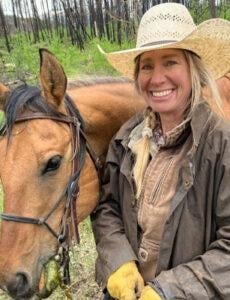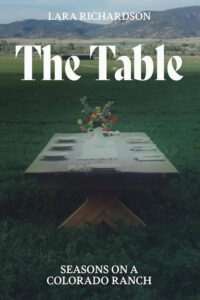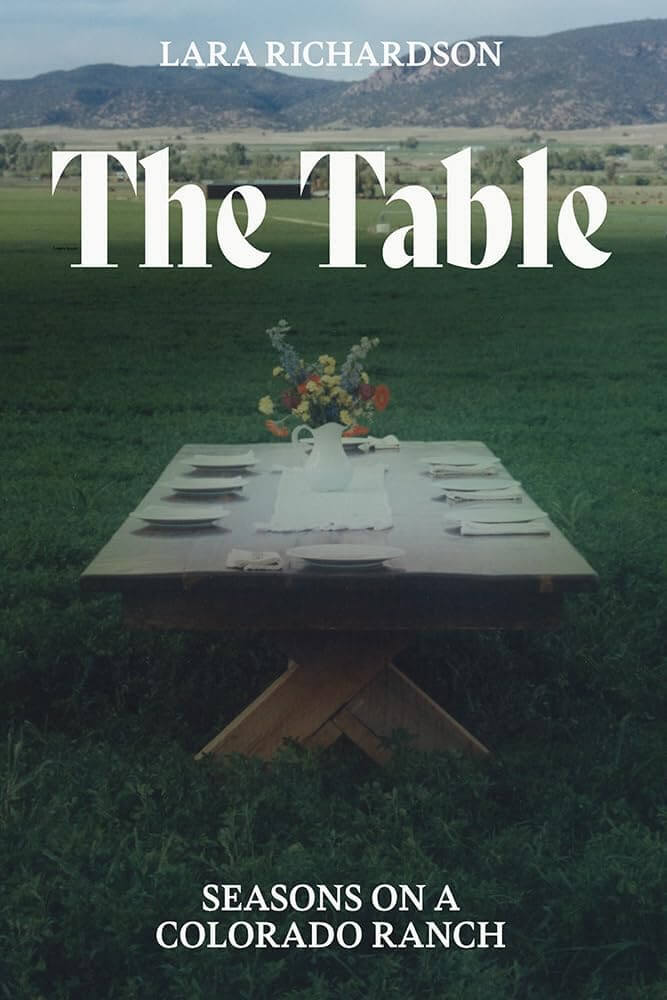Setting the table for tradition and change
Memoir explores ranching life in a fast-changing world
Memoir explores ranching life in a fast-changing world
In Colorado, nearly 39,000 ranches and farms raise livestock and produce dozens of crops. That industry covers nearly half of the state’s land mass and generates $47 billion in economic activity each year. Those statistics, reported by the U.S. Department of Agriculture, tell the big picture of ranching in Colorado.

Lara Richardson
In her memoir, The Table: Seasons on a Colorado Ranch, Lara Richardson takes readers behind the scenes of ranching life and sits them down at her dining room table to give a personal look at the realities of modern ranching. A 2021 graduate of Western Colorado University’s MFA Program in Nature Writing, Richardson was the first student in that program to have her work published as a book by Western Press Books. The Table is her first published work.
Richardson’s husband Andrew is a fifth-generation Colorado rancher who left a career as a landscape architect more than 20 years ago when he and Lara decided to move to the family ranch outside Salida, Colorado. There, with their five children—Grace, Naomi, Abe, Life, and Esther—they have watched as their community and the ranching industry have changed over the last two decades.
Each summer, the Richardsons raise over 300 grass-fed Hereford cows and calves and produce more than 30,000 bales of hay. Their ranch looks west to the 14,000-foot Collegiate peaks and, Richardson writes, is one of the last remaining farms in the valley.
The author uses the family table, that Andrew hand-built years ago from Engelmann spruce, as a place to sit her readers so she can tell the story of ranching, the family ranch and her family.
“With life comes hardship, tragedy, and loss …” she writes. “The table offers a place to recover and reshape as we look to lead our purposeful peaceful, and healthy lives.”
Richardson uses part of her memoir to educate readers about sustainable and ethical farming practices.
“As ranchers, though we are raising a product that we, and many others, will eventually eat to nourish our own bodies, we have a code of animal husbandry by which we live,” she writes. “It is motivated by respect. We honor the calves’ lives and respect them, caring for them in the most ethical ways we can, knowing that their lives will soon be taken so that many may live.” Richardson also argues for Country of Origin Labeling for beef products.
Because only one percent of Americans live on farms, Richardson writes, “… most of us are detached from  our food sources and are dangerously dependent upon others to provide our food. It is imperative that we are accurately informed about agriculture in the United States and that we support responsible agriculture before we further jeopardize the very industry that feeds us.”
our food sources and are dangerously dependent upon others to provide our food. It is imperative that we are accurately informed about agriculture in the United States and that we support responsible agriculture before we further jeopardize the very industry that feeds us.”
She and her husband have gotten accustomed to people’s reactions about their profession. “When people learn that Andrew and I raise beef cattle, there are often mixed reactions: some will ask us if we sell our beef, and if so, do we have any available, while others toss a quick word our way that beef is the main problem behind today’s climate crisis.”
Richardson welcomes the discussion and, throughout The Table, weaves in explanations of her family’s ranching practices through the years and her thoughts about the industry’s challenges. “Though the carbon footprint of a cow may not be as wide as some once thought, there is always room for improvement,” she writes.
But The Table is more than a tutorial on ranching. The death of beloved family members, their son’s struggle with an injury, and a series of events that led to them adopting a fifth child long after they had decided to not have any more children are piled on top of the daily stresses of keeping the ranch going. Like the rest of the world, the Richardsons weather the pandemic. And in a mysterious, tragic twist, a friend of the author’s goes missing and becomes the subject of a frustrating, high-profile search.
Something else beyond the family’s control lurks—the encroachment of land development creeping ever closer to their hayfield. Signs announcing sales or developments pop up and nearby land is sold and subdivided to meet housing needs in the booming Salida area. As some of their neighbors sell, the Richardsons are asked to lease or sell their land as well—for a solar farm, a hemp farm. Family discussions follow, the author writes: “Vacations, college funds, future careers, new cars, and the future of the ranch all dropped into the conversation.”
But in the end “we eventually concluded … that at this point in our lives, we would only buy the life we already have.”
That life, Richardson writes, is fulfilling in a way that only unending work can be: “When my life feels unstable and inconsistent, the ranch offers a gift: there is work that must always be done. The ranch requires us to leave our fragility behind for a time and focus on the job at hand. … And ranch work usually demands a focused mind—giving reprieve from the things that can weigh me down.”
The Table ends as it begins, with day after day of work that can be challenging and rewarding, joy-filled and tragic. “[The days] are not always easy,” Richardson writes. “They are full of stress, finances, aging parents, loss, a preschooler, the pandemic, a friend still missing, two college daughters adulting far away, and two teenage boys exploring what’s outside the fence. But really, if I truly think about it, I would not want my life to always be easy and forever the same. Growth brings change, and change, like that of the seasons, is healthy.”
Deb Acord is a journalist and author from Woodland Park, Colorado. For decades, she wrote for The Colorado Springs Gazette, Rocky Mountain News, Denver Post and The Indy. At the Gazette, she was co-creator of Out There, a section devoted to the outdoors of Colorado. She is the author of Colorado Winter and Biking Colorado’s Front Range Superguide and has writtten car trend stories and environmental stories for Popular Mechanics.
Click here for more from Deb Acord.

